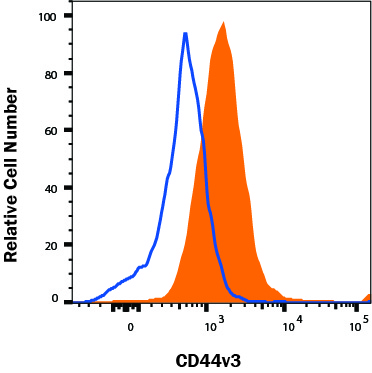Human CD44v3 Antibody Summary
Applications
Please Note: Optimal dilutions should be determined by each laboratory for each application. General Protocols are available in the Technical Information section on our website.
Scientific Data
 View Larger
View Larger
CD44 in Human PBMCs. CD44 was detected in immersion fixed human peripheral blood mononuclear cells (PBMCs) using 8 µg/mL Mouse Anti-Human CD44 v3 Monoclonal Antibody (Catalog # BBA11) for 3 hours at room temperature. Cells were stained (red) and counterstained (green). View our protocol for Fluorescent ICC Staining of Non-adherent Cells.
 View Larger
View Larger
Detection of CD44v3 in Human MDA-MB-231 by Flow Cytometry. MDA-MB-231 human breast adenocarcinoma cell line was stained with Mouse Anti-Human CD44s Pan Specific Monoclonal Antibody (Catalog # MAB7045, filled histogram) or isotype control antibody (MAB003, open histogram), followed by APC-conjugated Anti-Mouse IgG Secondary Antibody (F0101B).
Reconstitution Calculator
Preparation and Storage
- 12 months from date of receipt, -20 to -70 °C as supplied.
- 1 month, 2 to 8 °C under sterile conditions after reconstitution.
- 6 months, -20 to -70 °C under sterile conditions after reconstitution.
Background: CD44
CD44 is a ubiquitously expressed protein that is the major receptor for hyaluronan and exerts control over cell growth and migration (1‑3). Human CD44 has a 20 amino acid (aa) signal sequence, an extracellular domain (ECD) with a 100 aa hyaluronan-binding disulfide-stabilized link region and a 325‑530 aa stem region, a 21 aa transmembrane domain, and a 72 aa cytoplasmic domain. Within the stem, ten variably spliced exons (v1‑10, exons 6‑15) produce multiple protein isoforms (1‑3). The standard or hematopoietic form, CD44H, does not include the variable segments (1‑3). Cancer aggressiveness and T cell activation have been correlated with expression of specific isoforms (1, 3). With variable N‑ and O-glycosylation and splicing within the stalk, CD44 can range from 80 to 200 kDa (1). Within the N‑terminal invariant portion of the ECD (aa 21‑220), human CD44 shares 76%, 76%, 86%, 83% and 79% aa sequence identity with corresponding mouse, rat, equine, canine and bovine CD44, respectively. The many reported functions of CD44 fall within three categories (1). First, CD44 binds hyaluronan and other ligands within the extracellular matrix and can function as a “platform” for growth factors and metalloproteinases. Second, CD44 can function as a co-receptor that modifies activity of receptors including MET and the ERBB family of tyrosine kinases. Third, the CD44 intracellular domain links the plasma membrane to the actin cytoskeleton via the ERM proteins, ezrin, radixin and moesin. CD44 can be synthesized in a soluble form (4) or may be cleaved at multiple sites by either membrane-type matrix metalloproteinases, or ADAM proteases to produce soluble ectodomains (5, 6). The cellular portion may then undergo gamma secretase-dependent intramembrane cleavage to form an A beta -like transmembrane portion and a cytoplasmic signaling portion that affects gene expression (7, 8). These cleavage events are thought to promote metastasis by enhancing tumor cell motility and growth (1, 5).
- Ponta, H. et al. (2003) Nat. Rev. Mol. Cell Biol. 4:33.
- Screaton, G.R. et al. (1992) Proc. Natl. Acad. Sci. USA 89:12160.
- Lynch, K.W. (2004) Nat. Rev. Immunol. 4:931.
- Yu, Q. and B.P. Toole (1996) J. Biol. Chem. 271:20603.
- Nagano, O. and H. Saya (2004) Cancer Sci. 95:930.
- Nakamura, H. et al. (2004) Cancer Res. 64:876.
- Murakami, D. et al. (2003) Oncogene 22:1511.
- Lammich, S. et al. (2002) J. Biol. Chem. 277:44754.
- Fox, S.B. et al. (1994) Cancer Res. 54:4539.
Product Datasheets
Citations for Human CD44v3 Antibody
R&D Systems personnel manually curate a database that contains references using R&D Systems products. The data collected includes not only links to publications in PubMed, but also provides information about sample types, species, and experimental conditions.
7
Citations: Showing 1 - 7
Filter your results:
Filter by:
-
The Potential of CD16 on Plasma-Derived Exosomes as a Liquid Biomarker in Head and Neck Cancer
Authors: L Hofmann, S Ludwig, PJ Schuler, TK Hoffmann, C Brunner, MN Theodoraki
Int J Mol Sci, 2020-05-26;21(11):.
Species: Human
Sample Types: Whole Cells
Applications: Flow Cytometry -
CD44 targeted delivery of siRNA by using HA-decorated nanotechnologies for KRAS silencing in cancer treatment
Authors: A Tirella, K Kloc-Munia, L Good, J Ridden, M Ashford, S Puri, N Tirelli
Int J Pharm, 2019-02-26;0(0):.
Species: Human
Sample Types: Whole Cells
Applications: IHC -
MIF allele-dependent regulation of the MIF coreceptor CD44 and role in rheumatoid arthritis
Proc. Natl. Acad. Sci. U.S.A., 2016-11-21;113(49):E7917-E7926.
Species: Mouse
Sample Types: Whole Cells
Applications: Flow Cytometry -
Overexpression of progelatinase B/proMMP-9 affects migration regulatory pathways and impairs chronic lymphocytic leukemia cell homing to bone marrow and spleen.
Authors: Bailon E, Ugarte-Berzal E, Amigo-Jimenez I, Van den Steen P, Opdenakker G, Garcia-Marco J, Garcia-Pardo A
J Leukoc Biol, 2014-08-01;96(2):185-99.
Species: Human
Sample Types: Whole Cells
Applications: Flow Cytometry -
Epstein-Barr virus infection of polarized epithelial cells via the basolateral surface by memory B cell-mediated transfer infection.
Authors: Shannon-Lowe C, Rowe M
PLoS Pathog., 2011-05-05;7(5):e1001338.
Species: Human
Sample Types: Whole Cells
Applications: ICC -
Expression of the CD44v2-10 isoform confers a metastatic phenotype: importance of the heparan sulfate attachment site CD44v3.
Authors: Barbour AP, Reeder JA, Walsh MD, Fawcett J, Antalis TM, Gotley DC
Cancer Res., 2003-02-15;63(4):887-92.
Species: Human
Sample Types: Whole Tissue
Applications: IHC-P -
CD44 is exposed to the extracellular matrix at invasive sites in basal cell carcinomas.
Authors: Dingemans KP, Ramkema MD, Pals ST
Lab. Invest., 2002-03-01;82(3):313-22.
Species: Human
Sample Types: Whole Cells
Applications: Electron Microscopy
FAQs
No product specific FAQs exist for this product, however you may
View all Antibody FAQsReviews for Human CD44v3 Antibody
Average Rating: 5 (Based on 1 Review)
Have you used Human CD44v3 Antibody?
Submit a review and receive an Amazon gift card.
$25/€18/£15/$25CAN/¥75 Yuan/¥2500 Yen for a review with an image
$10/€7/£6/$10 CAD/¥70 Yuan/¥1110 Yen for a review without an image
Filter by:







